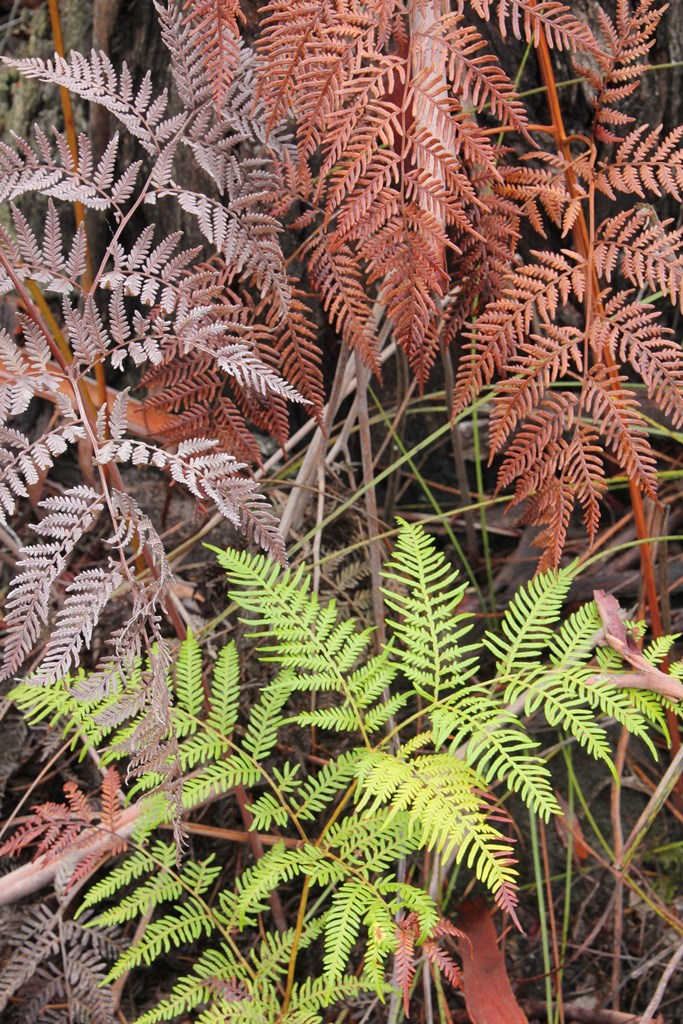Bracken is easy to overlook when compiling the A-Z Species Index because it is always there. Some people think of it as a weed, but it is a native Australian plant.
I can appreciate the beauty of its fern-like form, and the various colour variation as it proceeds through the life-cycle. It also provides great cover for wildlife. Many times I have startled a sleeping Swamp Wallaby or Kangaroo, along with the odd Echidna while walking. Wrens and other small birds build nests in the thicker pockets of bracken and tease me by popping up to make a warning call, then disappearing from sight just as I pull out the camera. Looking for orchids, lilies, low-growing heath and other interesting plants, I have to walk through bracken, part it to see what is growing beneath the fronds and try to see past it, looking for interesting shapes to photograph.
So, my day-to-day experience of bracken is quite tactile. I push past it, move it aside and bend it back. I rarely examine it closely, but when I do, it’s often because it catches light in an interesting way, or it’s in the frame of a photograph of something else, or new growth seems to be an iridescent green, or old growth looks silver. The texture is ridged or etched, and the edges of the leaves are so precisely defined.
I haven’t specifically taken a series of photographs of bracken for a post, but as I was looking through photographs of plants for to write a post, I kept finding photographs where bracken dominated. Suddenly, out of the blue, I had an idea. Why don’t I put bracken on the species list? However did I think of that!
Bracken grows from rhizomes and is one of the first plants to colonize areas which have been cleared or disturbed in other ways. It is extremely widespread in Australia. Unfortunately it cannot be used for grazing, as it makes the animals sick. As far as I can find out, it is not eaten by native wildlife either, so there is little to impede its growth. This often results in other native plants being unable to get space to grow, but I guess it also keeps out weeds, so that’s a two-edged sword.
The photographs I am using in this post are the ones I found tonight, but there are many more!







Pretty!
I know this is almost 9 years after you wrote this- but thankyou for giving this information. I have loved this bracken- it would grow in my yard and i tried hard to encourage it in certain areas that it seemed to be suited to. I wonder if it would be good to plant in paces where we have erosion of banks along creeks? At the back of the place I now live the lantana is the only thing that seems to be holding the bank from being undercut. Perhaps this bracken could be used as a native to gradually infiltrate the lantana?
Thanks for your comment, Katrina. To be honest, I don’t know if bracken would be good for that or not. It probably depends on the area and the other species. Is there a Field Naturalist group or a Landcare group in your area? They might be able to advise you. I simply don’t know the answer, and I don’t want to lead you down the wrong track..
Good luck with your research, Lisa
Thanks so much for getting me thinking this direction. I’m not sure if there’s any group I can contact where I’m now living but I have moved not too far from the Hunter Wetlands where they’d probably be aware of a group. Also the Local area Botanic Gardens might be able to direct me (even though they are approximately 20 kms away and in more sandy soil area closer to the Hunter river and estuary).
I’ve been so concerned that a previous owner had cut down a huge gum tree- it’s root system is where the major eroding is occurring! I am only a tenant but i know the current owners would be pleased if there were something that could be done even on a temporary basis.